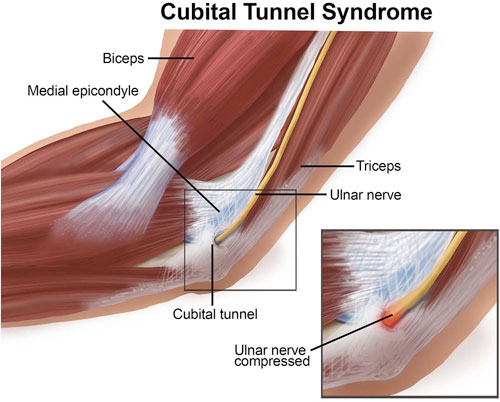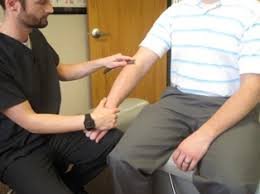nalco group
bone, muscle & joint pain physio
BOOK NOW / WHATSAPP ABOUT YOUR PAIN OR INJURY
- NOVENA 10 Sinaran Drive, Novena Medical Center #10-09, Singapore 307506
- TAMPINES 9 Tampines Grande #01-20 Singapore 528735
- SERANGOON 265 Serangoon Central Drive #04-269 Singapore 550265
Home > Blog > Physiotherapy & Hand Therapy > Conditions > Elbow Pain > Cubital Tunnel Syndrome Physiotherapy
Cubital Tunnel Syndrome Physiotherapy

Cubital tunnel syndrome is the second most common nerve compression occurring in the arm. (Carpal tunnel syndrome is the most common.)
It is caused mainly by prolonged increased pressure on the ulnar nerve at the elbow.
This pressure results in
- discomfort
- pain and
- may progress to loss of movement and functions of the hand
Cubital tunnel syndrome generally affects men more than women, especially those with jobs that require repetitive elbow movements and a bent elbow position, such as
- using tools like drills at work
- talking on the phone
- doing computer work
- painting or
- playing an instrument
Our senior hand therapists and senior physiotherapists help people with cubital tunnel syndrome
- reduce pain
- reduce swelling
- restore normal movement and function to the arm, wrist, and hand
first of all, What is Cubital Tunnel Syndrome?
Cubital tunnel syndrome is caused by compression of the ulnar nerve (medically termed as "ulnar nerve entrapment") when it passes under a bony bump (the medial epicondyle) on the inside portion of the elbow.
In this area, the nerve is relatively unprotected and can be trapped between the bone and the skin in a tunnel called the cubital tunnel. Although it is not an actual bone, this area is commonly called your “funny bone.”
When you hit the funny bone just the right way, you have actually hit the ulnar nerve.
This contact sends a sensation of
- tingling
- numbness
- burning and/or
- pain along the inside of your arm and down to the ring and little fingers
When the ulnar nerve is compressed, it causes the same type of symptoms. The ulnar nerve can be pinched at any point along its length, but the most common site of compression is on the cubital tunnel.
Signs and Symptoms of cubital tunnel syndrome
Cubital tunnel syndrome can occur after a traumatic incident, such as an elbow fracture, or develop slowly over time as a repetitive strain injury. It usually begins with numbness and/or tingling, or burning on the inside of the forearm extending down into the hand.
Typical symptoms include:
- Intermittent pain, numbness, and tingling brought on by sustained bending of the elbow
- Tenderness on the inside of the elbow where the nerve is close to the surface
Later symptoms sometimes include:
- Difficulty gripping and holding on to objects
- Muscle wasting of the small muscles of the hand
- A hand deformity in which the small and ring fingers bend inward, referred to as an "ulnar claw hand"
CAUTION: More severe symptoms, especially those with muscle wasting and hand deformities, should be evaluated by a physician.
How Is It Diagnosed?
Cubital tunnel syndrome can be diagnosed by a
- orthopedic surgeon or sports medicine physician
- senior hand therapist
- senior physiotherapist
We will typically perform a n in-depth comprehensive evaluation that should include assessment of your neck to rule out compression of the nerve where it starts in the neck. To confirm the compression of the ulnar nerve is occurring at the elbow, we may use the following tests and examination:
- Observation and inspection of the elbow and forearm
- Touching and moving the arm in the area of the nerve to determine its relationship to the elbow and its stability in the groove behind the elbow where the nerve travels
- Tapping the nerve at the elbow (the Tinel's sign test)
- Assessing the flexibility of the ulnar nerve
- A sensory examination that includes both light touch, a test of the ability to distinguish between sharp or dull stimulus, and the ability to distinguish 1 point from 2 points (2-point discrimination)
- Checking the strength of specific muscles of your hand
- Checking your pinching and gripping ability
Cubital tunnel syndrome can be accurately diagnosed clinically without additional testing.
Occasionally you may be referred for electrodiagnostic tests called
- electromyography (EMG) and/or
- nerve conduction study (NCS)
These tests evaluate the ability of the nerve to conduct signals along its full length. They can help determine the exact site of the compression and estimate the extent of the compression.
If our senior physiotherapists and/or senior hand therapists considers your symptoms to be more severe, they may refer you to a physician for an additional assessment.
how our senior hand therapists and senior physiotherapists can help

Many cases of mild to moderate cubital tunnel syndrome can be treated without surgery.
We will determine the activities that bring on your symptoms. The recommendations at this point will be to avoid those activities for a time. Remember, the nerve is irritated and at times swollen. If the irritation and swelling can be reduced, the symptoms should resolve.
In more advanced cases, we will modify your activity and may recommend you use a splint to take the pressure off the nerve. As your condition begins to improve, we may teach you:
Range-of-motion exercises
We will show you specific exercises to help return full length to the muscles of the arm that have shortened due to protective posturing, and to maintain the normal length of those that have remained unaffected.
Muscle strengthening exercises
Improving strength in the surrounding muscles can help reduce pain and improve functional ability.
Nerves have the ability to be stretched, just like muscles or joints. Nerve tissue is the strongest, longest tissue in the body and the one most sensitive to stretching. In cubital tunnel syndrome, the nerve can become tight or trapped; these exercises are an effective means of promoting blood flow to the ulnar nerve and gently stretching it.
We will teach you ways to avoid positions and postures that compress or put prolonged stretch on the ulnar nerve. You may need to learn how to modify work and self-care activities to prevent further nerve irritation.
If Surgery Is Required
More severe or prolonged cases of cubical tunnel syndrome may require surgery. The longer you have experienced symptoms and the more you experience
- weakness
- numbness
- tingling and
- pain
the more likely you are to need surgery. The #1 goal of cubital tunnel syndrome surgery is to relieve the pressure on the ulnar nerve.
Our senior hand therapists and senior physiotherapirsts will design an individual program of postsurgical physiotherapy and/or post-surgery hand therapy based on the nature of your operation and the surgeon’s instructions.
Each surgery will require a unique treatment
regimen, but your postsurgical rehabilitation will involve many of the
elements discussed above. Activity modification will be a big part of
your postsurgical rehabilitation to prevent your cubital tunnel syndrome from ever coming back.
